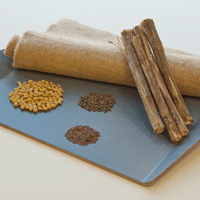Pros
+ Dynamically designed.
e2e biocomposites are moldable and more versatile than their wood-pulp counterparts.
+ Cost-neutral.
The materials are competitively priced with other nonsustainable products.
+ Bio-based.
e2e biocomposites are entirely bio-based and biodegradable, and as an added benefit, they are naturally flame-resistant.
Cons
— Longevity.
Because e2e biocomposites are biodegradable, ensuring durability is one of e2e’s primary concerns. Synthesis of new, natural lacquers and polymers are being developed.
Progressive Research
Preliminary research on e2e’s biocomposites began in 1992 at Cornell University, where Govang was working as the director of the Cornell Center for Materials Research. “I was working with a professor who had a background in synthesizing high-performance composites involving various resin systems and Kevlar and carbon-fiber composites,” Govang says. As the research came to show that it was possible to integrate two unlike materials, the professor was able to foresee how these materials would lead to cause environmental problems, so he began research on the synthesis of new, natural-binding systems that used soy flour as the chemical backbone. “In the early 2000s, there was considerable interest forming in green and sustainable solutions,” he says, “So with our technology and expertise, e2e was an outgrowth of that.”
Shifting Paradigm
“University technologies, like those we had developed at Cornell, can be very unique, but if there’s not a fit for them in the marketplace, they lose their value,” Govang says. While Govang and his partners were shopping around e2e, they utilized the momentum of the shifting paradigm to establish and fulfill a unique design need. With nearly $3.5 million in funding from various capital venture entities, such as Seed Capital Fund, Excell Partners, and NYSBTIF, and a biodegradable biocomposite equipped with 28 different patents and comprising 28 different natural fibers and resins, e2e is positioned to establish its offerings in markets totaling more than $65 billion. “With our formulated material and various project solutions,” Govang says, “our goal is working with customers to get these products into the marketplace.”
Soy Flour, et al
In 2004, formaldehyde was officially declared as a carcinogen, and many states began setting limits on its use in industrial design. “[e2e] doesn’t use any formaldehyde, petrochemicals, or other synthetic, carcinogenic materials in the construction of our products,” Govang says. “We receive consistently high marks for safety and sustainability.” The composites are made from soy flour and grass fibers such as jute, flax, and kenaf, a woody-stemmed plant cultivated for its fiber throughout Southeast Asia as well as in the United States. They are bound with natural epoxies to ensure sustained tensile strength, which is on par with glued particleboard and MDF. However, unlike these toxic materials, the construction of e2e biocomposites requires a third less energy to produce and has the potential to reduce the carbon footprint of the materials industry.
Made in USA (Really)
Although most wood materials are made from 4’ x 8’ sheets that are sawed, routed, and sent for manufacture, e2e biocomposites are highly moldable and render this intermediate step obsolete; therefore, enabling a more dynamic design approach. “This saves on time and energy,” Govang says, “and it substantially boosts efficiency.” e2e also incorporates what it calls regionally integrated manufacturing (RIM) for the material sourcing and job-creating schemata at its new 100,000-square-foot facility in Geneva, New York. RIM demands that the fibers that go into the e2e biocomposites be grown within a 100-mile radius of the manufacturing facility. Not only does this create new “green collar” jobs for people in the region, but it also reduces manufacturing costs and carbon footprints associated with transportation and processing. “For each manufacturing job we create in our facility, which totals around 200, we create five agricultural jobs,” Govang says.
Facility Siege
e2e Materials recently launched a new line of office products—desks, cabinets, boards, acoustic materials—that have multiplied the demand for e2e materials. “Right now, we fit in best with LEED-certified projects where groups are starting to look for solutions in commercial buildings that contribute to a LEED status,” Govang says. “We are able to boost customer LEED scores, and this offering helps us dispel the misconception in the marketplace that green products are more expensive.” With the RIM schemata in place, e2e also has plans to convert existing particleboard and MDF facilities into e2e Materials facilities. This has the potential to create more than 15,000 new jobs and save 1.6 million tons of greenhouse gas emissions. “We can take pride in that we are manufacturing items sourced from our neighbor’s feed stocks,” Govang says, “and we’ve been blessed with more demand than we can handle. We want to build a better American manufacturing paradigm that is cost-effective, environmentally conscious, and creates new jobs.”

